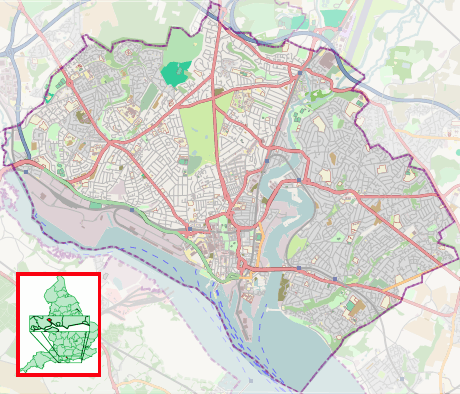Bargate
| Bargate | |
|---|---|
 | |
 Location within Southampton | |
| General information | |
| Type | Gatehouse |
| Architectural style | Medieval |
| Location | Southampton City Centre |
| Coordinates | 50°54′10″N 1°24′15″W / 50.9027°N 1.40415°W |
| Construction started | c. 1180 |
| Completed | c. 1180 |
| Owner | Southampton City Council |
| Technical details | |
| Floor count | 2 |
The Bargate is a Grade I listed medieval gatehouse in the city centre of Southampton, England. Constructed in Norman times as part of the Southampton town walls, it was the main gateway to the city. The building is a scheduled monument, which has served as a temporary exhibition and event space for Southampton Solent University since 2012.[1][2][3]
History
The Bargate was built c. 1180, constructed of stone and flint. Alterations were made to the building around 1290, when large drum towers were added to the north side, with arrow slit windows.[2][4]

A two-storey extension was made to the south side towards the end of the 13th century, with four windows lighting the upstairs room.[4] Work was also carried out to the interior of the upper room during the 13th century, when the stone fireplaces were installed.[4] The embattled north front was added to the building around 1400.[4] In 1605, the city's curfew and alarm bell was added to the southwest corner of the building.[4] In the middle of the four windows is a statue of George III in Roman dress, which replaced a wooden statue of Queen Anne.[4]
The room above the gate itself has known several uses. It was originally used as the city's guildhall, until the 1770s.[5] It was at this point that the city began to grow to the north of the gate.[6] Also during the 18th century, five panels containing painted shields and the sundial were added to the building.[4]
Additional archways were added in 1764 and 1774.[4] In 1765, a passage was cut through the eastern side of the arch for pedestrians. A further passage through the western side was added later.[6]
Following the establishment of Southampton's police force in February 1836, the upper room was used as a prison[7] but by 1899, the increase in road traffic and the introduction of trams led to proposals for its demolition.[8][9] It was reprieved at a subsequent council meeting[10] but the issue arose again in 1914[11] and 1923.[12] The Bargate was however eventually separated from the adjoining town walls in the 1930s[4] using a scheme previously suggested in 1900.[13] Around this time Portland cement was used in works on the bargate.[14] This was later to cause problems as it trapped water within the structure damaging the stones.[14]The monument again served as the police headquarters for the city during the Second World War.[15] After being used as a museum, the Bargate was then closed to the public for several years.
Between 2006 and 2012, following refurbishment funded by the South East England Development Agency, the upper room served as The Bargate Monument Gallery, during which time 42 exhibitions featuring the work of over 250 artists were staged here.[3][5]
In 2016 the Portland cement mortar that had been used on the structure in the 1930s was removed and replaced with lime mortar.[14][16] At the same time the parapet was waterproofed to prevent further water entering the structure.[14][16]
Historical images
-

The Bargate from the south in 1917
-

The Bargate from the south c. 1930, flanked by buildings and with tram lines running through the arch
References
| Wikimedia Commons has media related to Bargate. |
- ↑ "Southampton City Council: Listed buildings in Southampton" (PDF). Archived from the original (PDF) on 7 February 2012. Retrieved 13 September 2007.
- 1 2 Davis, Philip (24 July 2008). "SOUTHAMPTON TOWN WALL AND GODS HOUSE TOWER". The Gatehouse. Retrieved 2008-09-30.
- 1 2 "Bargate Monument Gallery". a space. Retrieved 2014-11-20.
- 1 2 3 4 5 6 7 8 9 "Sites and Monuments" (PDF). Southampton City Council. Archived (PDF) from the original on 1 October 2008. Retrieved 2008-09-30.
- 1 2 "zzzzz -About the Bargate - aspacearts". aspacearts.org.uk.
- 1 2 "A History of Southampton". localhistories.org.
- ↑ http://www.hants.gov.uk/hchs/soton.html
- ↑ "The Bargate". Hampshire Advertiser. 7 January 1899 – via British Newspaper Archive. (subscription required (help)).
- ↑ "In Defence of the Bargate". Hampshire Advertiser. 11 January 1899.
- ↑ "Southampton Bargate. Decision of the town council". Leicester Chronicle. 28 January 1899.
- ↑ "The Bargate". Western Daily Press. 9 April 1914.
- ↑ "Southampton Bargate Proposal". Portsmouth Evening News. 1 January 1923.
- ↑ "The traffic at Southampton Bargate. An important scheme". Hampshire Advertiser. 9 June 1900.
the most practical solution would be the construction of a circus for carriage traffic round the Bar, or a crescent on one side of it
- 1 2 3 4 "Restoration of Southampton's iconic Bargate to begin next month". southampton.gov.uk. Southampton City Council. 11 February 2016. Retrieved 16 September 2016.
- ↑ "bargate exhibition - ArtVaults in Context". Archived from the original on 19 September 2008. Retrieved 2008-09-30.
- 1 2 "Renovation of Southampton's iconic Bargate now complete". southampton.gov.uk. Southampton City Council. 26 July 2016. Retrieved 16 September 2016.